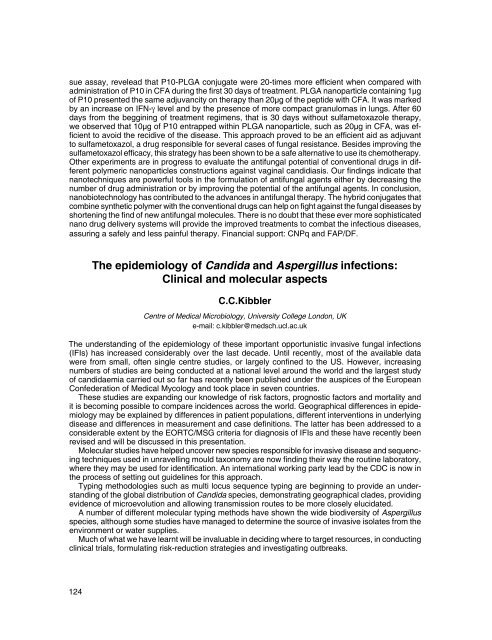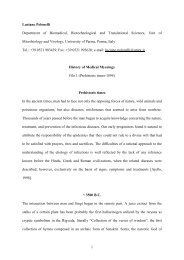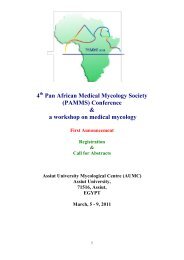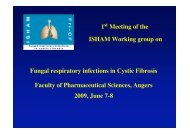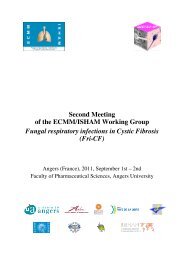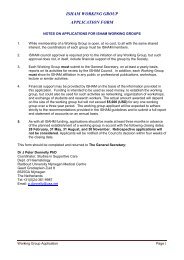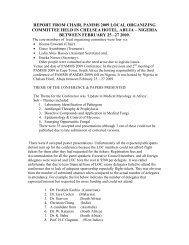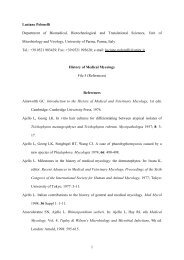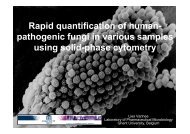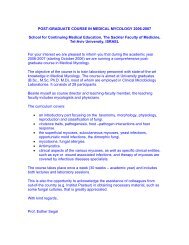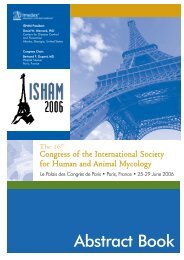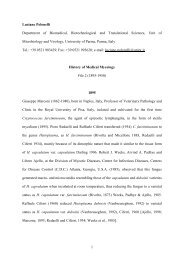Memoria CD.indd - ISHAM
Memoria CD.indd - ISHAM
Memoria CD.indd - ISHAM
You also want an ePaper? Increase the reach of your titles
YUMPU automatically turns print PDFs into web optimized ePapers that Google loves.
sue assay, revelead that P10-PLGA conjugate were 20-times more efficient when compared withadministration of P10 in CFA during the first 30 days of treatment. PLGA nanoparticle containing 1µgof P10 presented the same adjuvancity on therapy than 20µg of the peptide with CFA. It was markedby an increase on IFN-γ level and by the presence of more compact granulomas in lungs. After 60days from the beggining of treatment regimens, that is 30 days without sulfametoxazole therapy,we observed that 10µg of P10 entrapped within PLGA nanoparticle, such as 20µg in CFA, was efficientto avoid the recidive of the disease. This approach proved to be an efficient aid as adjuvantto sulfametoxazol, a drug responsible for several cases of fungal resistance. Besides improving thesulfametoxazol efficacy, this strategy has been shown to be a safe alternative to use its chemotherapy.Other experiments are in progress to evaluate the antifungal potential of conventional drugs in differentpolymeric nanoparticles constructions against vaginal candidiasis. Our findings indicate thatnanotechniques are powerful tools in the formulation of antifungal agents either by decreasing thenumber of drug administration or by improving the potential of the antifungal agents. In conclusion,nanobiotechnology has contributed to the advances in antifungal therapy. The hybrid conjugates thatcombine synthetic polymer with the conventional drugs can help on fight against the fungal diseases byshortening the find of new antifungal molecules. There is no doubt that these ever more sophisticatednano drug delivery systems will provide the improved treatments to combat the infectious diseases,assuring a safely and less painful therapy. Financial support: CNPq and FAP/DF.The epidemiology of Candida and Aspergillus infections:Clinical and molecular aspectsC.C.KibblerCentre of Medical Microbiology, University College London, UKe-mail: c.kibbler@medsch.ucl.ac.ukThe understanding of the epidemiology of these important opportunistic invasive fungal infections(IFIs) has increased considerably over the last decade. Until recently, most of the available datawere from small, often single centre studies, or largely confined to the US. However, increasingnumbers of studies are being conducted at a national level around the world and the largest studyof candidaemia carried out so far has recently been published under the auspices of the EuropeanConfederation of Medical Mycology and took place in seven countries.These studies are expanding our knowledge of risk factors, prognostic factors and mortality andit is becoming possible to compare incidences across the world. Geographical differences in epidemiologymay be explained by differences in patient populations, different interventions in underlyingdisease and differences in measurement and case definitions. The latter has been addressed to aconsiderable extent by the EORTC/MSG criteria for diagnosis of IFIs and these have recently beenrevised and will be discussed in this presentation.Molecular studies have helped uncover new species responsible for invasive disease and sequencingtechniques used in unravelling mould taxonomy are now finding their way the routine laboratory,where they may be used for identification. An international working party lead by the <strong>CD</strong>C is now inthe process of setting out guidelines for this approach.Typing methodologies such as multi locus sequence typing are beginning to provide an understandingof the global distribution of Candida species, demonstrating geographical clades, providingevidence of microevolution and allowing transmission routes to be more closely elucidated.A number of different molecular typing methods have shown the wide biodiversity of Aspergillusspecies, although some studies have managed to determine the source of invasive isolates from theenvironment or water supplies.Much of what we have learnt will be invaluable in deciding where to target resources, in conductingclinical trials, formulating risk-reduction strategies and investigating outbreaks.124


